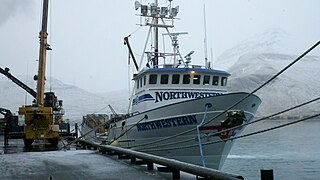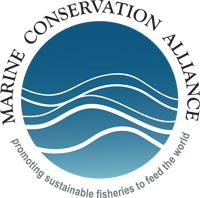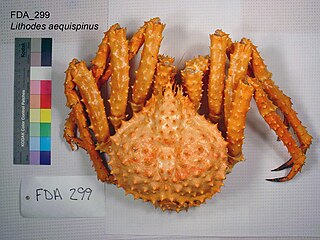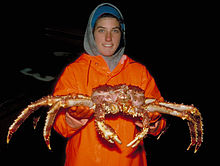
The Bering Sea is a marginal sea of the Northern Pacific Ocean. It forms, along with the Bering Strait, the divide between the two largest landmasses on Earth: Eurasia and the Americas. It comprises a deep water basin, which then rises through a narrow slope into the shallower water above the continental shelves. The Bering Sea is named after Vitus Bering, a Danish-born Russian navigator, who, in 1728, was the first European to systematically explore it, sailing from the Pacific Ocean northward to the Arctic Ocean.

Petersburg is a census-designated place (CDP) in and essentially the borough seat of Petersburg Borough, Alaska, United States. The population was 3,043 at the 2020 census, up from 2,948 in 2010.

A fisherman or fisher is someone who captures fish and other animals from a body of water, or gathers shellfish.

Trawling is an industrial method of fishing that involves pulling a fishing net through the water behind one or more boats. The net used for trawling is called a trawl. This principle requires netting bags which are towed through water to catch different species of fishes or sometimes targeted species. Trawls are often called towed gear or dragged gear.

The Dungeness crab makes up one of the most important seafood industries along the west coast of North America. Its typical range extends from Alaska's Aleutian Islands to Point Conception, near Santa Barbara, California. Dungeness typically grow 6–7 in (150–180 mm) at their widest point and inhabit eelgrass beds and sandy bottoms. Its common name comes from the Dungeness Spit in the Strait of Juan de Fuca, Washington state, United States, which shelters a shallow bay inhabited by the crabs.

Commercial fishing is the activity of catching fish and other seafood for commercial profit, mostly from wild fisheries. It provides a large quantity of food to many countries around the world, but those who practice it as an industry must often pursue fish far into the ocean under adverse conditions. Large-scale commercial fishing is called industrial fishing.

Lobsters are widely fished around the world for their meat. They are often hard to catch in large numbers, but their large size can make them a profitable catch. Although the majority of the targeted species are tropical, the majority of the global catch is in temperate waters.

Deadliest Catch is an American reality television series that premiered on the Discovery Channel on April 12, 2005. The show follows crab fishermen aboard fishing vessels in the Bering Sea during the Alaskan king crab and snow crab fishing seasons. The base of operations for the fishing fleet is the Aleutian Islands port of Dutch Harbor, Alaska. Produced for the Discovery Channel, the show's title is derived from the inherent high risk of injury or death associated with this line of work.
Individual fishing quotas (IFQs), also known as "individual transferable quotas" (ITQs), are one kind of catch share, a means by which many governments regulate fishing. The regulator sets a species-specific total allowable catch (TAC), typically by weight and for a given time period. A dedicated portion of the TAC, called quota shares, is then allocated to individuals. Quotas can typically be bought, sold and leased, a feature called transferability. As of 2008, 148 major fisheries around the world had adopted some variant of this approach, along with approximately 100 smaller fisheries in individual countries. Approximately 10% of the marine harvest was managed by ITQs as of 2008. The first countries to adopt individual fishing quotas were the Netherlands, Iceland and Canada in the late 1970s, and the most recent is the United States Scallop General Category IFQ Program in 2010. The first country to adopt individual transferable quotas as a national policy was New Zealand in 1986.

F/V Northwestern is an Alaskan crab, Pacific cod, and salmon tendering commercial fishing vessel featured in the Discovery Channel series Deadliest Catch. To date the Northwestern is the only vessel to have featured on all 20 seasons of Deadliest Catch as well as the pilot series America's Deadliest Season. The vessel is owned and operated by the Hansen family of the state of Washington with Sig Hansen serving as the vessel's primary captain.

Chionoecetes bairdi is a species of snow crab, alternatively known as bairdi crab and tanner crab. C. bairdi is closely related to Chionoecetes opilio, and it can be difficult to distinguish C. opilio from C. bairdi. Both species are found in the Bering Sea and are sold commercially under the name "snow crab." Tanner crabs have suffered from overfishing and as a result strict controls have been placed on tanner crab fisheries. It was named by Mary Jane Rathbun, a Smithsonian employee who became one of the leading authorities on crab taxonomy. She named the crab for Spencer Baird, her mentor, who in the 1880s as Secretary of the Smithsonian Institution and head of the United States Fish Commission, had given her her first position.

Commercial fishing is a major industry in Alaska, and has been for hundreds of years. Alaska Natives have been harvesting salmon and many other types of fish for millennia Including king crab. Russians came to Alaska to harvest its abundance of sealife, as well as Japanese and other Asian cultures.
This page is a list of fishing topics.

As with other countries, the 200 nautical miles (370 km) exclusive economic zone (EEZ) off the coast of the United States gives its fishing industry special fishing rights. It covers 11.4 million square kilometres, which is the second largest zone in the world, exceeding the land area of the United States.
Catch share is a fishery management system that allocates a secure privilege to harvest a specific area or percentage of a fishery's total catch to individuals, communities, or associations. Examples of catch shares are individual transferable quota (ITQs), individual fishing quota (IFQs), territorial use rights for fishing (TURFs), limited access privileges (LAPs), sectors, and dedicated access privileges (DAPs).
A community-supported fishery (CSF) is an alternative business model for selling fresh, locally sourced seafood. CSF programs, modeled after increasingly popular community-supported agriculture programs, offer members weekly shares of fresh seafood for a pre-paid membership fee. The first CSF program was started in Port Clyde, Maine, in 2007, and similar CSF programs have since been started across the United States and in Europe. Community supported fisheries aim to promote a positive relationship between fishermen, consumers, and the ocean by providing high-quality, locally caught seafood to members. CSF programs began as a method to help marine ecosystems recover from the effects of overfishing while maintaining a thriving fishing community.

The Marine Conservation Alliance (MCA) is a Juneau, Alaska-based coalition of seafood processors, harvesters, support industries and coastal communities that participate in Alaska fisheries. The coalition was established in 2001 by fishery associations, communities, Community Development Quota (CDQ) groups, harvesters, processors and support businesses, to promote science-based conservation measures to ensure sustainable Alaska fisheries.

Crab traps are used to bait, lure, and catch crabs for commercial or recreational use. Crabbing or crab fishing is the recreational hobby and commercial occupation of fishing for crabs. Different types of traps are used depending on the type of crab being fished for, geographic location, and personal preference.
Corey Arnold is an American fine art, documentary, and commercial photographer and commercial fisherman, based in Portland, Oregon. His work explores man's relationship with the natural world, animals, and environmental issues with a primary focus on the Alaskan wilderness. Since 2002 he has photographed his life at sea while working as a Bering Sea crab fisherman and during his summers as a captain of a Bristol Bay sockeye salmon fishing boat in Alaska.

Lithodes aequispinus, the golden king crab, also known as the brown king crab, is a king crab species native to the North Pacific. Golden king crabs are primarily found in the Aleutian Islands and waters nearer to Alaska and British Columbia; their range also extends to the Russian far east and Japan, albeit with a less dense population. Golden king crabs are the smallest of the three commercially viable Alaskan king crab species with an average weight between 5 and 8 lbs ; the other two species being the blue and red king crabs. Golden king crabs were historically caught incidentally in red king crab fisheries, but the first commercial landing took place in 1975; in 1981, the targeted pot-fishing method, a hybrid fishing method specifically for golden king crab, was developed.



















